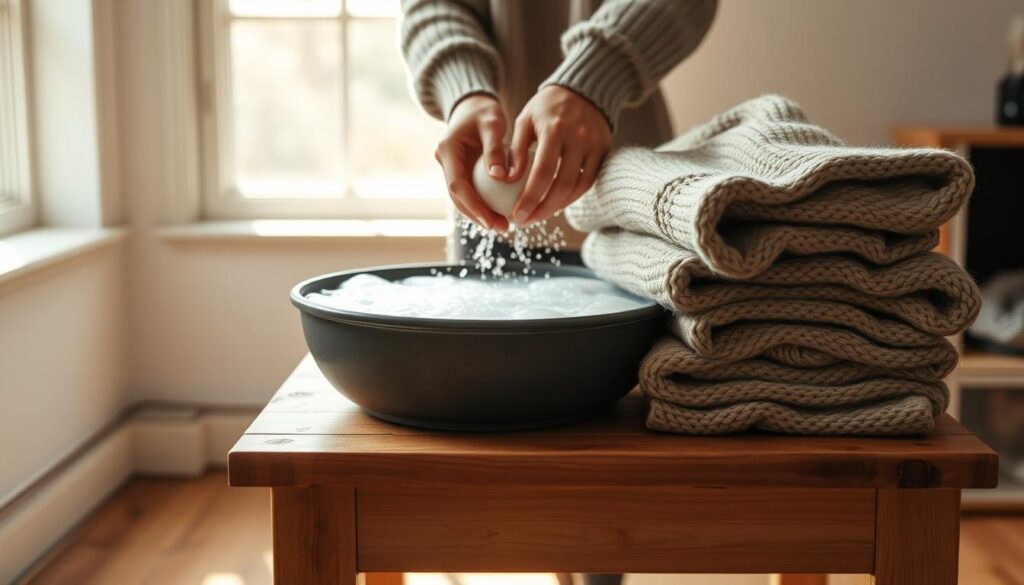Delicate fabrics like silk, wool, and cashmere demand more than a quick spin in the washing machine. Many assume a gentle cycle or mild detergent is enough, but harsh agitation, hot water, or the wrong soap can weaken fibers, fade colors, or cause pilling. Proper hand washing is key to preserving their softness and longevity.
Discover how to hand wash delicate fabrics correctly with this guide. Learn the steps to protect your investments, avoid common mistakes, and extend the life of your silk, wool, and cashmere items. The right techniques ensure these luxurious materials stay beautiful for years.
Key Takeaways
- Hand washing prevents damage caused by machine agitation and extreme temperatures.
- Specialized detergents are essential for delicate fabric care.
- Ignoring care labels can lead to irreversible shrinkage or color loss.
- Proper drying and storage methods maintain fabric integrity.
- Misconceptions about “easy” cleaning shortcuts often cause hidden damage.
Why Hand Washing is Important for Delicate Fabrics
Proper delicate fabric care requires understanding the unique needs of materials like silk, wool, and cashmere. Hand washing provides the control needed to protect these fibers from damage. When done correctly, it ensures longevity and maintains the luxurious feel of your garments.
Benefits of Hand Washing
Hand washing offers unmatched precision in caring for delicate fabrics. This method prevents stretching, shape distortion, and fiber breakdown. By controlling water temperature and detergent application, you preserve natural textures and colors. For example, silk retains its sheen, while wool stays soft without losing loft. Regular hand washing also reduces pilling and extends the life of high-end garments.
Differences Between Hand Washing and Machine Washing
- Mechanical agitation in machines can cause wool to felt, shrinking it irreversibly.
- High-speed spin cycles tear silk fibers, leading to weakened fabric structure.
- Cashmere exposed to machine washes develops pills faster due to abrasive forces.
Machines—even on delicate cycles—use harsh motions that compromise delicate fabric washing tips. Hand washing eliminates these risks by allowing full control over every step.
Choosing the Right Detergent for Delicate Fabrics
Protecting silk, wool, and cashmere starts with choosing the right detergent. Harsh chemicals in standard laundry soaps can strip natural oils, fade colors, or even break down fibers over time. The right products ensure longevity and maintain the softness of your garments.
Recommended Products
Opt for detergents designed for delicate fabric care. Top choices include:
- Eucalan: A no-rinse formula safe for silk hand washing and wool, free of synthetic dyes and enzymes.
- Soak: pH-neutral and enzyme-free, ideal for wool garment cleaning and cashmere.
- The Laundress Delicate Wash: Gentle surfactants that clean without residue.
- Dr. Bronner’s Unscented Castile Soap: A natural alternative for small loads when diluted properly.
What to Avoid in Detergents
Avoid these ingredients when selecting products:
- Enzymes: Break down protein fibers in wool and silk.
- Bleach: Destroys natural fibers and weakens fabric structure.
- Optical brighteners: Cause yellowing in white or light-colored garments.
- Strong fragrances: Can irritate skin and damage delicate materials.
Stick to mild, fragrance-free options labeled for delicate items. Always test a small area first to prevent unexpected reactions.
Preparing Your Fabrics for Washing
Before starting the hand-washing process, proper preparation ensures your delicate items stay in top condition. Follow these steps to extend the lifespan of silk, wool, and cashmere garments using delicate fabric cleaning techniques.
Pre-Treating Stains
Address stains gently to avoid damaging fibers:
- Blot spills immediately with a clean cloth—never rub.
- Use mild solutions like diluted white vinegar for food stains or makeup.
- For oil-based stains, dab with a wool-specific cleaner like Ecover Delicate Wash.
- Test treatments on an inconspicuous area first.
Checking Fabric Care Labels
Labels provide critical instructions. Review symbols like:
| Symbol | Meaning |
|---|---|
| Bucket with hand | Hand wash only |
| X on washer | Avoid machine washing |
| Triangle with circle | Professional dry cleaning recommended |
Always prioritize instructions for caring for delicate fabrics, especially when hand washing cashmere sweaters. Misreading symbols can lead to shrinkage or pilling.
The Best Water Temperature for Hand Washing
Mastering water temperature is key to protecting delicate fabrics during hand washing. Using the right temperature prevents damage while ensuring effective cleaning. Here’s how to avoid common mistakes in delicate fabric washing tips.
Ideal Temperatures for Different Fabrics
| Fabric Type | Ideal Temperature (°F/°C) | Notes |
|---|---|---|
| Silk | 85–95°F (29–35°C) | Lukewarm water maintains silk’s protein fibers without causing shrinkage. |
| Wool | 65–85°F (18–29°C) | Cool to lukewarm prevents felting and maintains structure. |
| Cashmere | 60–70°F (15–21°C) | Cool water preserves softness and prevents pilling. |
How Temperature Affects Fabric Care
Extreme heat damages protein-based fabrics like silk and wool. Water over 100°F (38°C) causes fibers to shrink or felt. Cashmere’s delicate structure needs cooler temps to avoid damage. Conversely, cold water (below 60°F/15°C) may leave oils on the fabric. Here’s what to remember:
- Use a thermometer for accuracy.
- Test water on skin: lukewarm should feel comfortable, not hot.
Following these delicate fabric washing tips ensures longevity. Always check care labels and adjust based on fabric thickness. Proper temperature control is a simple step that makes a big difference in preserving your garments.
Step-by-Step Guide to Hand Washing Silk
Protecting silk requires precision. Start by gathering the right tools to avoid damage. Here’s what you need:
Essentials You’ll Need
- Mild detergent (e.g., Woolite Delicates or Eucalan)
- Lukewarm water (95°F max)
- Large basin or sink
- White microfiber towel
- pH testing strips (optional)
Washing Process Overview
Follow this method to preserve silk’s luster:
- Soak silk in prepared solution for 5-7 minutes.
- Gently agitate using upward/downward motions—never scrub.
- Rinse in clean water until suds disappear.
- Press excess water with towel—never twist.
| Step | Action | Why It Works |
|---|---|---|
| 1 | Test water pH with strips | Ensures neutral balance to prevent discoloration |
| 2 | Use mesh laundry bag | Protects against snagging |
Delicate fabric cleaning techniques like this minimize friction. Avoid wringing—this causes irreversible damage. Always air-dry flat away from direct heat. Silk hand washing demands patience but maintains fabric integrity for years.
Step-by-Step Guide to Hand Washing Wool

Hand washing wool requires precision to avoid shrinkage and maintain texture. Unlike silk, wool fibers need specialized care to retain their natural lanolin and prevent felting. Follow these steps for effective wool garment cleaning.
Essentials You’ll Need
- Wool-specific detergent (e.g., Woolite, Eucalan, or Rinsell)
- Large basin or sink
- Mesh laundry bag (for reshaping)
- Mild white vinegar (optional)
- Cotton towels
Washing Process Overview
- Fill basin with lukewarm water (80–90°F). Add 2–3 tbsp detergent and stir gently.
- Submerge garment fully, squeezing water through fabric without twisting.
- Soak 10–15 minutes. For heavy soiling, pre-treat stains with diluted detergent.
- Rinse in same-temperature water. Add vinegar for softness if desired.
- Press out excess water. Lay flat on towel, reshape, and air-dry flat or on a hanger.
| Wool Type | Care Tip |
|---|---|
| Merino | Use cooler water to avoid damaging fine fibers |
| Lambswool | Handle extra gently due to delicate fibers |
| Shetland | Soak longer to remove lanolin buildup |
Step-by-Step Guide to Hand Washing Cashmere
Cashmere requires meticulous care to preserve its softness and structure. Follow these steps for cashmere sweater hand wash to extend the life of your garments. Avoid harsh treatments that lead to pilling or shrinkage.
Essentials You’ll Need
Start with these supplies to ensure proper delicate fabric care:
- Ultra-gentle detergent: Opt for pH-neutral formulas like Eucalan or The Laundress Cashmere Shampoo.
- Water softener tablets for hard water areas to prevent fiber damage.
- A large plastic basin or sink lined with a microfiber cloth to protect fibers.
- Non-terry towels to air-dry items flat.
Washing Process Overview
Follow this method for caring for delicate fabrics like cashmere:
- Fill the basin with lukewarm water (80-90°F). Mix in detergent and water softener until suds form.
- Submerge the garment fully, pressing gently to saturate fibers. Soak 5-10 minutes without scrubbing.
- Squeeze water out gently—never wring. Lay flat on a towel, reshaping the garment if needed.
- Air-dry away from direct heat. Fluff fibers lightly after drying to restore softness.
Pro tip: Check care labels for specific instructions. Cashmere blends (e.g., 70% cashmere) may require adjusted techniques.
Tips for Rinsing Delicate Fabrics
Proper rinsing is a vital step in delicate fabric washing tips that many overlook. To protect silk, wool, and cashmere, follow these steps to ensure fibers stay soft and long-lasting.
Rinse Water Temperature
Match rinse water to the wash temperature to avoid damaging fibers. Use these guidelines:
-
- Silk:
75–85°F (24–29°C)
-
- Wool:
80–95°F (27–35°C)
-
- Cashmere:
70–80°F (21–27°C)
How to Properly Rinse
Follow these steps for thorough rinsing:
- Submerge fabric fully in clean water until suds disappear.
- Use a press-and-release motion to release trapped detergent.
- Replace water 2–3 times until water runs clear.
For extra softness, add ¼ cup white vinegar to the final rinse—avoiding wool, which vinegar can weaken.
Failure to rinse properly leaves detergent residue, causing stiffness or skin irritation. Always check fabric care labels before adding additives.
Drying Techniques for Silk, Wool, and Cashmere
Proper drying is essential to preserve the integrity of delicate fabrics. Skipping this step can lead to shrinkage, distortion, or loss of texture. Follow these methods to extend the life of your silk, wool, and cashmere garments.

Air Drying Methods
Start by laying items flat on a clean towel or mesh rack. For silk, drape it over a towel to avoid stretching. Wool garments should be reshaped while damp to retain their structure. Cashmere benefits from being rolled in a dry towel to remove excess water before air-drying flat. Always dry in a shaded area—direct sunlight fades colors.
- Silk: Dry face-down on a breathable surface.
- Wool: Reshape seams and lay flat to prevent creasing.
- Cashmere: Use a towel roll method to soak up moisture first.
Avoiding Common Drying Mistakes
Steer clear of these pitfalls to protect your investments:
- Hanging by delicate areas stretches fabrics. Use padded hangers only when nearly dry.
- Never use dryers or heat tools—heat damages fibers.
- Twisting to remove water causes structural damage. Pat gently instead.
Always check care labels before drying. Proper techniques paired with delicate fabric care ensure longevity. For silk, follow silk hand washing best practices even after washing. Wool requires extra care during wool garment cleaning drying phases.
Storing Delicate Fabrics After Washing
Proper storage extends the life of silk, wool, and cashmere. Follow these steps to maintain their quality after hand washing. Always ensure fabrics are fully dry before storing to prevent mildew growth. The right environment and methods protect against damage over time.
Best Practices for Storing Silk, Wool, and Cashmere
Use these guidelines for delicate fabric care:
| Fabric Type | Storage Method |
|---|---|
| Silk | Hang using wide-hangers to avoid creases. Avoid direct sunlight. |
| Wool | Store in breathable cotton garment bags. Use cedar chips for moth prevention. |
| Cashmere | Roll in acid-free tissue paper. Pair with lavender sachets to repel pests. |
Common Storage Mistakes to Avoid
- Plastic containers trap moisture, causing yellowing or mustiness.
- Overcrowded closets create pressure points, leading to permanent wrinkles.
- Direct sunlight fades colors and weakens fibers.
- Ignoring pest control risks damage from moths or dust mites.
Always clean garment surfaces before storage. For cashmere sweater hand wash items, check for loose threads and mend seams before packing. Rotate seasonal storage spaces yearly to ensure even air circulation.
Troubleshooting Common Hand Washing Issues
Even with careful delicate fabric cleaning techniques, issues like shrinkage or color loss can arise. Addressing these problems promptly helps preserve your garments’ quality and longevity.
What to Do if Fabrics Shrink
Shrinkage often happens when protein fibers like hand washing silk and wool encounter heat or harsh agitation. Try these steps:
- Soak shrunken items in lukewarm water mixed with a wool-specific conditioner or vinegar to relax fibers.
- Gently stretch the fabric to its original shape while damp, supporting delicate areas with a towel.
- For wool, lay the item flat on a towel and pin it to the desired dimensions before air-drying.
Note: Extreme shrinkage may require professional restoration.
Handling Color Bleeding
If dyes bleed during washing:
- Stop the process immediately and rinse the fabric in cold water.
- Use color catcher sheets during rinsing to absorb loose dyes.
- For persistent bleeding, apply a diluted white vinegar solution and rewash separately.
Prevent future issues by testing new garments with a cloth swatch before full washing. Always follow delicate fabric washing tips like washing similar colors together and avoiding bleach.
Excessive wrinkling? Roll damp items in a dry towel to absorb moisture, then lay flat to air-dry. For lingering odors, sprinkle baking soda on fabrics before storage. Prioritizing these fixes ensures your silks and wools stay vibrant and intact.
Conclusion: Caring for Your Delicate Fabrics
Proper delicate fabric care ensures your silk, wool, and cashmere items stay vibrant and durable. By following the how to hand wash delicate fabrics (silk, wool, & cashmere) steps outlined, you protect investments in high-quality garments. Each step—from selecting gentle detergents to air-drying techniques—plays a role in extending their lifespan.
Recap of Key Points
Always use mild detergents like Eucalan or Woolite to avoid damaging fibers. Adjust water temperatures: cool for silk, lukewarm for wool, and tepid for cashmere. Gently agitate fabrics without twisting, then rinse thoroughly. Lay flat to dry and store folded—not hung—to prevent stretching. Address shrinkage or bleeding immediately using methods from this guide.
Encouragement for Proper Fabric Care
Investing time in caring for delicate fabrics rewards you with garments that age gracefully. Prioritizing hand washing over machine cycles preserves natural fibers and prevents costly replacements. Sustainable practices like these reduce waste and align with mindful consumption. With consistent care, your favorite items become heirlooms, not disposables. Small efforts today mean lasting beauty and value tomorrow.


1 thought on “Mastering the Art of Hand Washing Silk, Wool, & Cashmere”
Comments are closed.